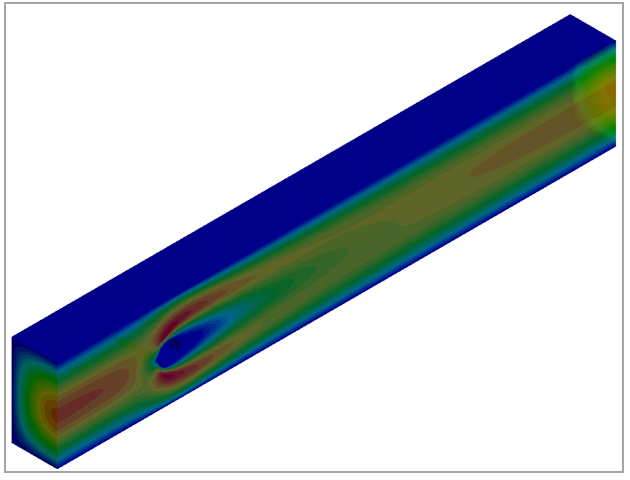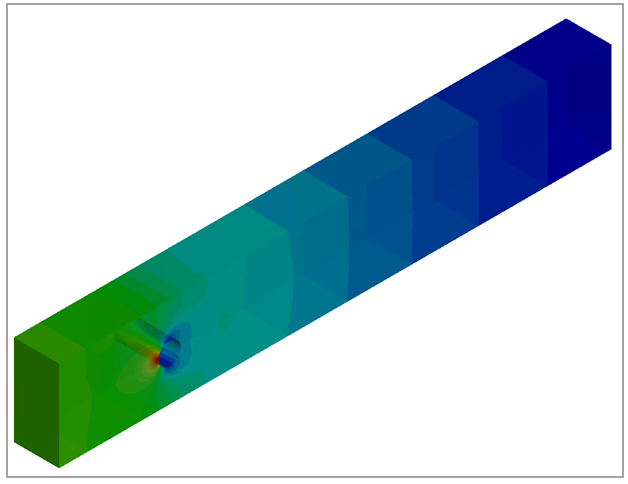VM-LSDYNA-FLUID-006
VM-LSDYNA-FLUID-006
Steady 3D Laminar Flow around a Cylinder in a Channel
Overview
| Reference: | Schäfer, M., Turek, S., Durst, F., Krause, E., & Rannacher, R. (1996). Benchmark computations of laminar flow around a cylinder. In: Hirschel, E.H. (eds) Flow simulation with high-performance computers II. Notes on numerical fluid mechanics (NNFM), vol 48. Vieweg+Teubner Verlag (pp.547–566). |
| Analysis Type(s): | Incompressible CFD |
| Input Files: | Link to Input Files Download Page |
Test Case
This test case reproduces a three-dimensional, steady, incompressible laminar flow around a cylinder inside a channel. The test uses the ICFD steady solver. The purpose is to validate the drag and lift force coefficients and the pressure difference between the front and end points of the cylinder.
The domain consists of a box (the channel) with an inflow at prescribed velocity and an outflow at prescribed pressure. The lateral sides of the boundary (the channel walls) and the cylinder feature a non-slip condition. The domain size and relevant quantities are shown in Figure 151. As you can see, the cylinder location is not perfectly symmetrical with respect to the channel height in the y direction. For this test case, all units of measure are consistent (length = m, time = s, mass = kg, force = N, pressure = Pa).
| Material Properties | Geometric Properties | Loading |
|---|---|---|
|
Fluid: Fluid density ρ = 1 Inflow max velocity in channel axial direction Um = 0.45 Flow dynamic viscosity μ = 10-3 |
Mesh size: Fluid boundaries elements size: 0.01 Cylinder elements size: 0.003 Anisotropic elements added to cylinder Boundary Layer: 5 Anisotropic elements added to channel Boundary Layer: 3 Geometry: Cylinder Diameter D = 0.1 Channel Height/Width H = 0.41 |
Fluid: Outflow pressure p = 0 |
Analysis Assumptions and Modeling Notes
Two meshing boxes have been used to selectively refine the mesh around the cylinder and its wake (see Figure 152).
The behavior of the flow is characterized by the Reynolds number:
(20) |
where is the fluid's density,
is the characteristic length of the problem (the cylinder diameter), and
is the dynamic viscosity of the flow.
is the flow mean velocity at the channel's inlet:
(21) |
where is the velocity field in the channel's axial direction, which is imposed at
the inlet (x = 0). The complete inflow velocity field
relationship is
(22) |
where is the maximum inflow velocity in the channel’s axial direction. This
yields a Reynolds number
.
In this test, values of drag, and lift coefficients (respectively, and
) are compared to the same values available in the reference.
The nondimensional coefficients are evaluated using the following relationship:
(23) |
where is the relative dimensional force on the cylinder surface. Note that the
drag force is the resultant force on the cylinder in the asymptotic flow direction (x
direction), the lift force is the resultant force on the cylinder orthogonal to the asymptotic
flow direction (y direction), and both forces are the sum of pressure and viscous
forces.
As a further reference value, the pressure difference
is defined, with the front and rear points of the cylinder (
,
,
) = (0.45, 0.2, 0.205) and (
,
,
) = (0.55, 0.2, 0.205), respectively.
A picture of the domain's mesh is shown in Figure 153, while Figure 154 shows a detail of the mesh refinement around the cylinder and the channel's walls.
Results Comparison
Figure 155 shows the flow velocity contours on the channels' outer surfaces and on a transparent section in the x-y plane for z = 0.205. You can see the symmetric laminar steady separation downstream of the cylinder as well as the boundary layer developing along the channel's walls. Likewise, Figure 156 shows the pressure contours.
The results table shows a comparison of drag and lift coefficients ( and
) and pressure difference
between the present analysis and the reference. The reference proposes a
comparison of the same values calculated with a variety of different numerical methods. The
value shown in the target column is the average between the upper and lower bounds for each
variable.
| Result | Target | LS-DYNA | Error (%) |
|---|---|---|---|
| 6.1500 | 6.1244 | 1.41% | |
| 0.0090 | 0.0088 | 1.57% | |
| 0.1750 | 0.17004 | 2.83% |








